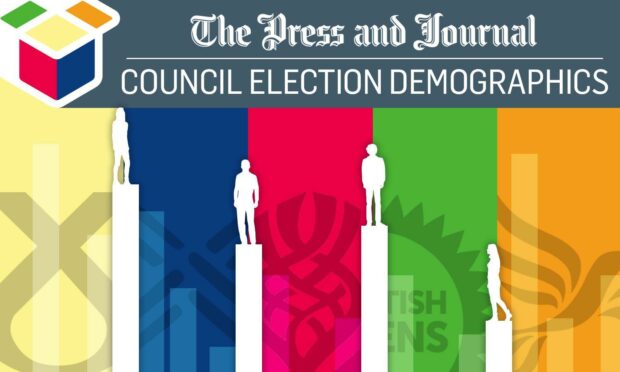The next Scottish council election will be held on Thursday – It rolls round every five years, and is a decision that impacts our day to day lives.
Each resident places votes within their own local authority, which is split up into constituencies.
We’ve looked at data surrounding the candidates standing for this year’s election, as well as some key demographics from past elections including 2017, 2012 and 2007.
Who is standing for election?
The below table includes the names and party of every candidate who is standing in this year’s election.
Search for your constituency below to find a list of candidates.
Which party has the most candidates?
Political parties can choose to put forward several candidates for council elections, and often do.
This gives parties a better chance of having a majority administration in the local authority if several councillors in each ward are of one party,
As a result, we’ve looked at how many candidates are standing for each party.
The party with the most candidates is the SNP, with over 550 people hoping to be elected.
This is followed by 417 from the Scottish Conservative and Unionist Party, 378 Labour Party candidates and 357 people standing independently from any political parties.
Other popular choices include the Liberal Democrats with 267 candidates, the Scottish Green Party with 239 and the Alba Party with 111. The Scottish Family Party also has 84 candidates.
All other parties have less than 50 candidates, with several only one candidate.
But what is their favourite biscuit?
Community interest company Democracy Club collects data from candidates across the UK standing for election, to bring together information such as social media profiles and email addresses, to help make sure constituents can find out information about those they could vote for.
As part of this, within its profiles it asks one additional piece of information: what is your favourite biscuit?
Of those standing for the Scottish local council elections, 85 responded out of 2,548 candidates – only 3.33%. Two others responded but with answers that were not related to biscuits.
We’ve compiled the responses from those standing in Scotland into the table below, in case you’re interested whether any of the candidates for your ward were happy to provide additional information about themselves.
Of those who responded, chocolate biscuits were the most popular, while others listed their brand preference for Tunnock’s.
Others gave answers that aren’t technically biscuits, such as After Eights and Kinder Bueno.
Previous election demographics
This year’s ballot will take place on May 5 – but what were the past elections like?
Gender split
Data from Scottish Parliament body SPICe shows that the gender breakdown of candidates over the past three elections has been improving.
In 2007, the Liberal Democrats had the largest proportion of female candidates, at 30.9%, compared to 69.1% male candidates.
This was followed by the Conservatives at 24.6% female, SNP at 21.5% female, independents, other and Greens at 20.8% and Labour at 19.3%.
Since then, the number of female candidates standing for election has increased, and even doubled in some cases.
In 2012, the Green Party took the lead with 41.8% of its candidates female, followed by the Liberal Democrats which dropped slightly to 27.5% female. Labour grew to 27.2%, while the Conservatives had 26% and the SNP 23.8%.
For the 2017 election, the Green Party had an almost equal split in gender for its candidates, with 45.4% female candidates and 54.6% male.
The SNP doubled its female candidates to 41.3% female, while 32.8% were female in the Liberal Democrats, 31.9% in the Labour party and 21.3% of Scottish Conservatives.
At the last elections, other parties standing and independents had the lowest gender balance, with 81.6% of candidates male.
How many candidates actually become councillors?
Thousands of people stand for election – but not everyone can be elected.
Across Scotland, there are 2,548 people hoping to get elected this year, with candidates from major parties, smaller parties or standing as an independent individual.
The number of candidates since 2007 has been generally falling, although not by much.
The party with the highest number of councillors elected at the last election was the Scottish Conservative and Unionist Party, which had 72.6% of those standing for election gaining a seat.
This was followed by 68.7% of SNP candidates, and 57.8% of Scottish Labour Party candidates.
A total of 27.1% of Scottish Liberal Democrats candidates were elected in 2017, 26.6% of those standing as independents and other parties, and 8.7% of Scottish Green Party candidates.
Are people voting?
The turnout for the Scottish council elections is generally not as high as other elections such as the Scottish Parliament elections and the General election.
Across Scotland, the vote turnout including votes that were rejected was 55.9% for the last Scottish Parliament election. For the last Scottish Council election in 2017, the average turnout across all wards in Scotland was 47.4%.
In the last council elections, Glasgow City had the lowest turnout at only 39%, while East Renfrewshire had the highest at 58.8%.
It was however, an improvement from the 2012 elections, where the lowest turnout was again Glasgow, with 32.2%, and the highest was Shetland at 54.7%,
Despite the rise, it is still a fall from the turnout seen in 2007.
